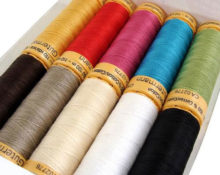Threads are the oldest human invention for joining materials in the production of clothing and shoes. They were originally made from animal veins or plant stems. But over time, they began to use a fibrous base of plant, animal or artificial origin. Plant materials are obtained from cotton and flax, animal materials are obtained from sheep wool and silkworm cocoons. Threads obtained from different materials differ in their properties and characteristics and have different applications. The principle of creation remains the same among them - torsion, i.e. These are products that are made by twisting fibers.

Production stages
According to the raw material composition, threads are divided into cotton, linen, wool, silk and artificial. By purpose - for sewing, knitting, embroidery and darning. Sewing threads are most widely used. Their composition may vary, but cotton and synthetic ones are most often used.Linen ones find a rather narrow application, and silk ones are usually replaced with artificial analogues.
Sewing threads must have sufficient strength so that their breaks do not interrupt the operation of the machines in which they are used.. The range of knitting threads is much smaller than sewing threads and is represented mainly by cotton and wool types, less often artificial ones. Woolen and wool blends, i.e. with the addition of chemical types, are used both in hand knitting and machine knitting methods, and are called yarn. There are even fewer varieties of embroidery and darning threads due to the low demand for them.

It is more convenient to consider the manufacturing process using the example of cotton threads, since compared to other types it is the most multi-stage. Mandatory stages of production are caning, twisting and finishing.
- The task of the first is to add several layers of raw materials.
- On the second, the thickness and strength of the product are formed. To do this, the raw materials are twisted in two, three, six, nine and twelve folds and wound onto reels.
- The third stage is designed to form the required appearance of the threads. For this purpose, they are rewound into balls and boiled in a slightly alkaline solution to remove foreign impurities.
- After this operation, the product is obtained in yellowish or gray tones.
- Before dyeing, those threads that will later be white are bleached using a solution of sodium chloride compounds, as well as hydrogen peroxide. The threads are dyed black and other colors immediately after boiling, because in this case the original color does not matter.
Attention! The dyes used must be of high quality so that they are well fixed in the products and are not removed during washing.
Features of shine
In order for the threads to obtain the required presentation, to become strong and smooth, they undergo finishing and polishing. The finishing agent consists of starch, resins and other substances. It is designed for processing twisted products to give them rigidity and wrinkle resistance. Its specific composition is determined by the type of threads.
To obtain a shiny surface, a sizing agent with a high starch content is used as an adhesive that glues the fibers together. The result is a smooth surface. To create a shine effect, stearin and sometimes wax are used. To protect cotton fibers from moisture, in order to increase their durability, antiseptics are added. To obtain a matte surface and softness, silicon-containing components and fatty components are increased in the composition of the dressing.

The finishing operation for threads with a smooth surface ends with polishing. For this purpose, drums are used, the design of which includes special brushes. After processing in them, the products receive the necessary shine. This is the last stage of production, which ends with winding the finished threads onto spools.
In the production of synthetic threads, specially developed artificial raw materials are used. To obtain fibers of a given thickness, strength and length, it is melted and passed through holes under high pressure. The further stages of production are the same as described above, but the resulting threads do not require finishing and polishing, since this is taken into account when creating raw materials.
Strength
Finished products must be checked for strength and stretchability.According to the technological process, this indicator is formed at the torsion stage. Therefore, first of all, the strength of the threads depends on their thickness and on the number of twists and folds that were performed during manufacture. The quality and type of product have a significant impact on this characteristic. The most durable are synthetic threads, in which this indicator can be programmed at the stage of development of raw materials.


 0
0





